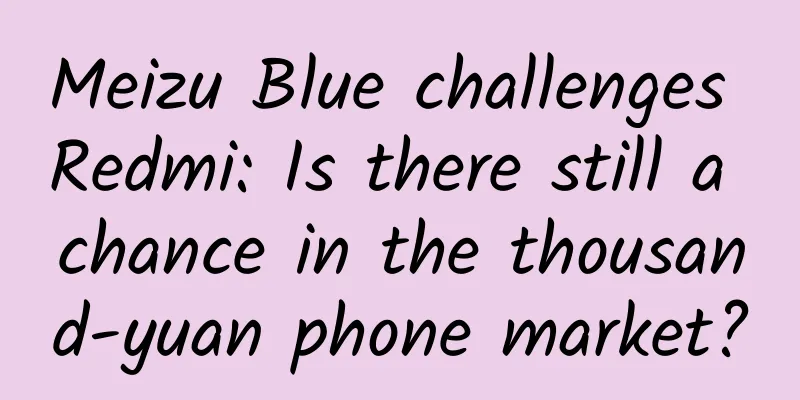Meizu Blue challenges Redmi: Is there still a chance in the thousand-yuan phone market?

|
There have been rumors that Meizu will launch a thousand-yuan phone this year, but it has never been confirmed by Meizu officials. Today, Meizu finally released new product release information and confirmed that it will hold a new product launch conference at the Beijing National Convention Center on December 23 this year. The invitation page shows the new brand "no blue", and the Chinese name is likely to be the "Mei Lan" that was previously circulated by the outside world. According to previous rumors, the Meizu Blue phone is the previously exposed Meizu K52, equipped with MT6752 octa-core 64-bit processor, equipped with a 4.6-inch 1080p screen, built-in 13-megapixel camera, 2GB memory and 16GB body storage, the back cover material is similar to the material of iPhone 5c, with a variety of colors, and the price is likely to be 700 yuan. The outside world generally believes that this is a phone launched by Meizu to snatch the thousand-yuan phone market. Judging from the invitation letter and the shell of iPhone 5C, Meizu is very likely to follow the same concept as Xiaomi did when it launched the Xiaomi TV last year, with "the first mobile phone for young people" as its main concept. Meizu Blue will use colorful, fashionable and youthful design elements to counter the Redmi mobile phone, which has no design elements, and attract young people to buy it. According to the price rhythm of Meizu's new product releases this year, I have no doubt that the Meizu Blue phone will give Meizu fans a surprise price, but it is difficult to guess the details, but it will definitely be differentiated from Redmi. Will Meizu Blue smartphones have an impact on the 1,000-yuan smartphone market, where price competition is fiercest? Perhaps, but it will not be a happy ending. Meizu has already missed the wave of 1,000-yuan smartphones. In the 1,000-yuan smartphone market dominated by Redmi, Meizu Blue’s attempt to seize Redmi’s market share is undoubtedly pulling teeth out of a tiger’s mouth. Thousand-yuan phones compete not on price but on brand awareness Many people mistakenly believe that the thousand-yuan phone market is a price-based market segment, and the cheaper the phone, the more popular it is. But I have to say here that this is a complete fallacy! Users who buy thousand-yuan phones do care more about cost-effectiveness. Among two phones with the same performance, the cheaper phone will be more popular. However, that was only in the era of grassroots copycat phones, when prices were more attractive to users. But judging from the popularity of Redmi phones, users actually care more about brand awareness. There were also mobile phone brands such as Huawei, ZTE, Samsung, Coolpad, etc. in the thousand-yuan phone market before, but they did not pay much attention to this market segment, believing that cheap phones were not profitable. Xiaomi has achieved its current success, and Xiaomi phones certainly contributed to it, but Redmi is the wave behind Xiaomi becoming the world's third largest mobile phone brand. Xiaomi has grown from its founding in 2011 to the present day, and has become the world's third largest mobile phone manufacturer in four years. Its development speed is ferocious. In the eyes of most people, the impression of Xiaomi phones is "this is a cost-effective phone", so it is right to choose it. More importantly, in the minds of many purchasing users, Xiaomi has premium ability. This premium ability may come from MIUI, the Xiaomi brand, Mi fans and other factors, but in the end, the result is that buying Xiaomi is a "not inappropriate" choice. In the eyes of users, Xiaomi is a moderate brand. It is not particularly expensive, but it is not particularly good. It is just OK. However, this "OK" factor is in line with the moderate nature of most Chinese people. It is called moderate, but it is actually the nature of following the crowd. If something is popular and everyone likes it, then I will buy it. There was a joke on the Internet that teased Xiaomi and Apple users: "Only users who can't afford Apple will buy Xiaomi." It is simple and crude, and it hits the heart. This marketing comparison makes users have the illusion of a "Chinese version of Apple". Meizu is still a long way behind Xiaomi in terms of brand building, especially offline, in the eyes of ordinary users. Especially in second-tier, third-tier and fourth-tier cities and rural areas, if you ask people around you, most young people know Xiaomi, but not everyone knows Meizu. This is the significant gap in brand awareness between Xiaomi and Meizu. The largest user scale of the thousand-yuan phone market is in economically underdeveloped areas. Why would users buy Meizu instead of Xiaomi when Meizu has no brand awareness? Perhaps in rural areas, for users there, Meizu is not much different from most Chinese copycat manufacturers. Anyway, they don't know or understand. Thousand-yuan phones compete with supply chain capacity Meizu released MX4 and MX4 Pro this year, which are both well-received and popular products. Meizu's series of changes this year have almost changed the fate of the entire Meizu. At the launch of Meizu Blue mobile phone, Meizu will definitely give users a surprise in terms of price and configuration. There is no doubt about this. This is the trick that Xiaomi has tried and tested in the past and is also loved by mainstream users. But the most important thing is, judging from the production capacity of MX4 and MX4 Pro, can that limited production capacity trigger the explosion of Meizu Blue mobile phones? Why did MX4 explode in September this year and become tepid now? It is nothing more than being dragged down by Meizu's production capacity. Meizu gave users a lot of expectations, created a "beautiful dream", and then coldly told you "out of stock!" Isn't this just teasing you! If you really want to buy MX4 at the original price, you can either make a reservation and wait for Meizu's production capacity to recover, or you can buy it at a higher price. The Meizu Blue mobile phone is no different. It attracts users with attractive prices and good appearance design, making users feel "itchy". Then Meizu asks users to make reservations on the official website. There is no stock, or there is a small amount of stock, but you have to grab it. It is completely playing with users in the same way as Xiaomi did in the past. Why are there so many Mi haters online? They are all Mi fans who were cheated by Xiaomi in the early days and turned to hate to express their anger. Meizu is now playing the same tricks as Xiaomi in the past, and will eventually be turned against by its own Meizu fans. Xiaomi knew from the beginning that playing this kind of "thick black" trick would be criticized by everyone. Lei Jun knew the flaws of this model, but fortunately, people only complained that they couldn't buy it, rather than not buying it at all. If the product is not available, as long as the production capacity keeps up, the anger in the hearts of users can be blocked. If the product is not popular with users, it is a completely rubbish product. Therefore, Lei Jun has been making up for Xiaomi's shortcomings in the product supply chain in recent years. It was not until this year that Xiaomi's product supply chain was relatively complete. The deep cooperation between Xiaomi and Foxconn means that Meizu and Xiaomi are not competitors at the same level in terms of production capacity and speed. What I am worried about is not the product problems of Meizu Blue phones, but the defects of Meizu itself and the shortcomings of insufficient production capacity, which cannot meet user needs. The thousand-yuan phone market that Meizu is competing for is the most competitive market among domestic mobile phones. Meizu is facing far more than just its arch-rival Redmi. It also has to face a series of strong opponents such as Honor, Nubia, Lenovo, Coolpad and others. I don't think that with Meizu's current strength, it can have much influence in the thousand-yuan phone market, which is already highly competitive. Perhaps the purpose of Meizu in promoting Meizu Blue phones is not to compete with Redmi, but just to snatch users from the thousand-yuan phone market. As a winner of Toutiao's Qingyun Plan and Baijiahao's Bai+ Plan, the 2019 Baidu Digital Author of the Year, the Baijiahao's Most Popular Author in the Technology Field, the 2019 Sogou Technology and Culture Author, and the 2021 Baijiahao Quarterly Influential Creator, he has won many awards, including the 2013 Sohu Best Industry Media Person, the 2015 China New Media Entrepreneurship Competition Beijing Third Place, the 2015 Guangmang Experience Award, the 2015 China New Media Entrepreneurship Competition Finals Third Place, and the 2018 Baidu Dynamic Annual Powerful Celebrity. |
<<: What is the charm of new energy vehicles? Why are Internet giants competing to invest in them?
>>: Xiaomi banned in India: Why didn’t this happen in China?
Recommend
A comprehensive analysis of Pinduoduo’s “Get Cash Every Day” campaign!
Regarding Pinduoduo 's "Get Cash Every D...
Fungi can only be eaten? They can also be used to build houses, clothes, and electronic devices
Fungi are not only edible, they can also be used ...
You were busy celebrating the National Day, but these big things happened in the technology circle
[[151069]] Large companies October 3: Google offi...
Tesla asks suppliers to refund money, trying hard to save cash flow
Tesla asked some suppliers to return part of the ...
Apple sells ads on the App Store, what does this mean?
How are Apple App Store’s default search ads made...
How to choose a TV at this stage? Don’t buy 4K, 1080p is the best
It's the TV buying season again, and the &quo...
"I love the ocean, and I love you too!" If scientists become romantic, you will have nothing to do with them
From "One Desk, Two Academicians" Yuan ...
App Operation丨Apple Cleaning Free List Top 200! More than 40 games were removed from the list
Clearing words, locking rankings , removing from ...
How many levels are there in Taobao Live? How to upgrade Taobao Live level?
This article mainly introduces the levels of Taob...
They sold you cancer, but said it was a way to keep healthy.
This article was reviewed by Pa Li Ze, chief phys...
Will the Apple Watch be a hit?
[[129121]] Here it comes, the Apple Watch is fina...
Ningde SEO Training: What are the conditions for doing SEO well? Do you know them all?
In the process of SEO optimization , many SEO sta...
Huang Shiming: Stop the inner war you started: Get rid of internal friction and gain a free life audio course
Huang Shiming: Stop the inner war you started: Ge...
Starting operations from scratch: Keep’s 100-day advancement
There is a reason why Keep is so popular. The ope...
Web3.0--Introduction to Decentralized Identity DID
Part 01 Internet identity 1.1 Internet identity c...









